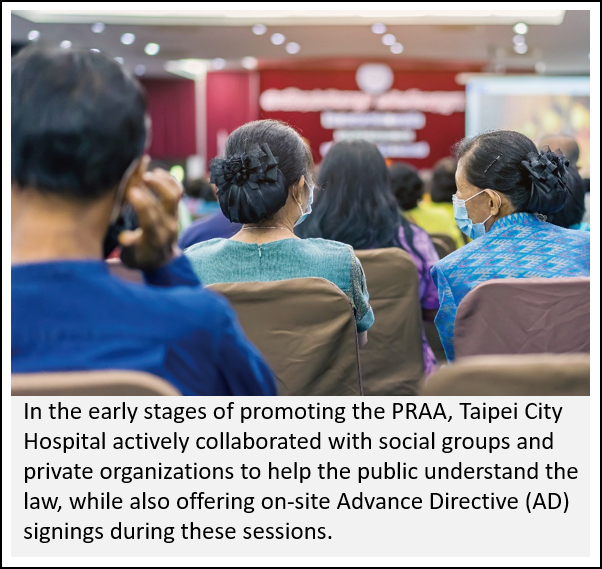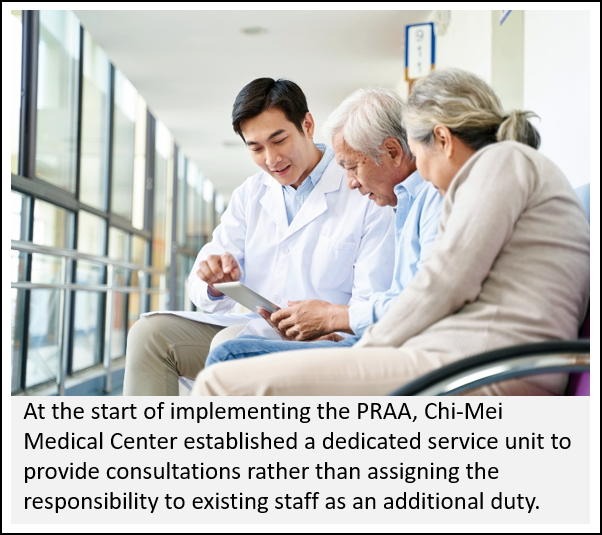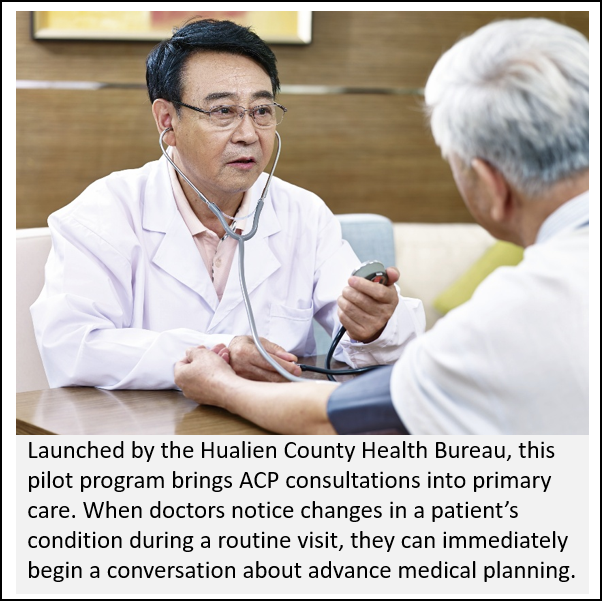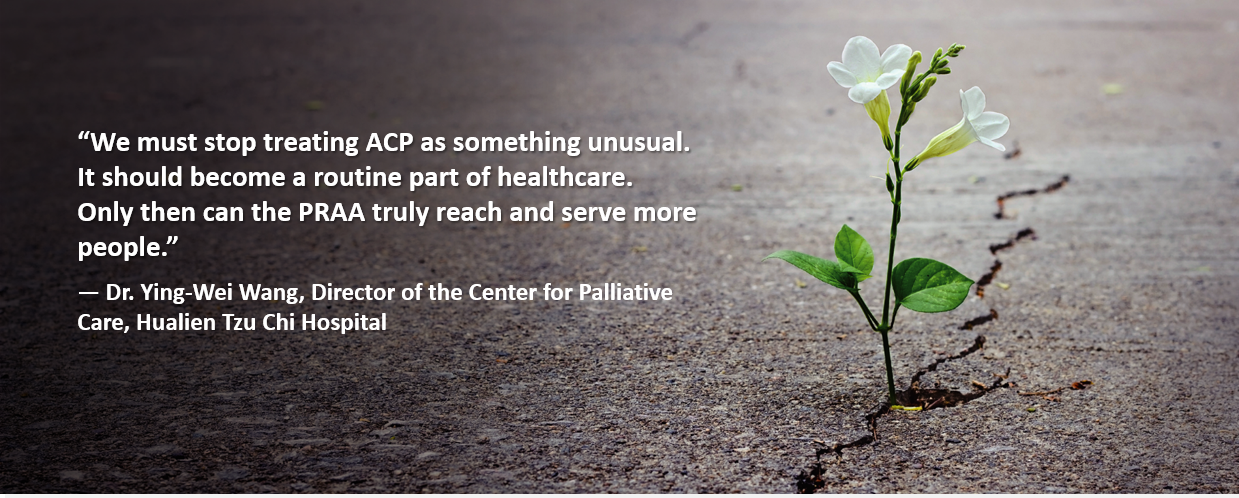Six years have passed since the implementation of the Patient Right to Autonomy Act. On the clinical frontlines, healthcare professionals have proceeded with caution and dedication—starting from understanding the law, to overcoming challenges such as limited counseling staff, difficulties with Advance Directive signing, and obstacles in implementation. Every step has been a leap into uncharted territory. Yet, they have chosen to shoulder the profound responsibility of honoring patients' wishes for a good death with dedication and compassion.
The Patient Right to Autonomy Act (commonly referred to as the PRAA) is not only Taiwan’s first piece of medical legislation centered on the patient, but also the first comprehensive law in all of Asia to protect a patient’s right to make autonomous medical decisions. Through Advance Care Planning (ACP), individuals can sign an Advance Directive (AD) to ensure their medical choices are respected.
But as with all pioneering efforts, the journey has not been without headwinds. Frontline professionals have faced ongoing challenges yet continued to press forward, enabling the PRAA to take root and flourish across Taiwan over the past six years—blossoming into a visible and lasting cultural change.
The First Year
A Journey from Nothing to Something
 “Although the Patient Right to Autonomy Act (PRAA) officially took effect on January 6, 2019, it had already been passed in late 2015 and announced on January 6, 2016,” said Dr. Wen-Jung Sun, then Director of the Community Medicine Department & Family Medicine Division at Taipei City Hospital (now practicing in Family Medicine at Tainan Municipal Hospital). In those early days, the clinical field was completely lost. In his own words: “This was an entirely new law. What exactly did it say? How were we supposed to implement it? We simply had no idea.”
“Although the Patient Right to Autonomy Act (PRAA) officially took effect on January 6, 2019, it had already been passed in late 2015 and announced on January 6, 2016,” said Dr. Wen-Jung Sun, then Director of the Community Medicine Department & Family Medicine Division at Taipei City Hospital (now practicing in Family Medicine at Tainan Municipal Hospital). In those early days, the clinical field was completely lost. In his own words: “This was an entirely new law. What exactly did it say? How were we supposed to implement it? We simply had no idea.”
At the time, Dr. Sheng-Jean Huang, Superintendent of Taipei City Hospital and a member of the expert panel for the PRAA, decisively committed the hospital to serving as a demonstration site. The day after the law passed, he convened a meeting with relevant departments, determined to transform the black-and-white legal text into lived reality through internal consensus and dedicated education programs.
Dr. Sun, who joined these efforts from the start, candidly shared that even with promotional videos, public understanding of the law remained vague. Although the hospital offered a regular ACP clinic every Tuesday, few people actually summoned the courage to register for a consultation. Most were hesitant and remained on the sidelines.
Seeing the public’s uncertainty, Dr. Sun and his team decided to take the message beyond the hospital walls. They began engaging with community groups, institutions, and even small reading clubs. In these venues, they set up projectors, distributed informational booklets, and helped clarify concepts and stimulate reflection. “As long as they showed interest,” he said, “we would make the time to go to people. We also provided on-site AD signing and uploaded the documents immediately via scanning.”
To encourage participation, Taipei City Hospital set the ACP consultation fee at the lowest possible rate. Family members who accompanied patients were offered a discounted price of NT$800, and elderly individuals, low-income households, and other underprivileged groups were eligible for additional subsidies. “Many people searched online, saw that we were the most affordable option, and that’s what brought many of them to us,” Dr. Sun added.
Growing Through Learning
Frontline Challenges and Testimonies
As public outreach began to ripple outward, the challenges facing the clinical frontlines also began to emerge.
Dr. Chun-Yi Yang, Director of the Department of Social Work at Taipei City Hospital, shared that although her department was designated as the lead unit for promoting the PRAA, the law’s provisions were extensive and complex, so that even after undergoing intensive training, the team still struggled to fully grasp the Act’s legal clauses, implementation procedures, and underlying philosophy.
To strengthen outreach, the hospital decided to produce a promotional video. Before the filming began, Yang recalled that she was filled with anxiety, saying: “I kept asking myself—if even I don’t fully understand the law myself, how could I explain it to others?”
Her concerns reflected the dilemma shared by many frontline healthcare workers during the early stages of the PRAA’s implementation. With no precedent to follow, they relied solely on their training and cautiously navigated each case in clinical practice. Even now, six years after the law took effect, patient questions often prompt the team to pause, clarify, research, and discuss before offering a thoughtful reply.
“Even today, we’re still constantly learning,” Dr. Yang reflected, recalling two ALS (Amyotrophic Lateral Sclerosis) patients her team had guided through end-of-life planning. The first patient arrived at the hospital having already lost all mobility and met the criteria to activate the PRAA. “During our discussions, he asked how the PRAA differed from the Hospice Palliative Care Act. Even now, that’s still a question many people can’t clearly answer—nor could we at the time,” Dr. Yang said.
The team delved into research, comparing the two laws in detail before finally offering a response. The process not only helped the patient, but also deepened the team’s own understanding of the PRAA’s essence.
The second ALS patient also met the activation criteria. He was mentally alert and expressed clearly, “I want to activate the law now, while I’m still aware, and not after I’ve already lost that awareness.” In his case, activation meant removing the ventilator. While this was legally compliant, Yang did not immediately give her approval. She remembered the first ALS patient telling her how, during a brief power outage the ventilator had stopped momentarily, and even that short interruption had caused such unbearable agony that he never wanted to experience it again.
“This very patient had never experienced that. We had to have further conversations to ensure he was truly ready to face death,” Dr. Yang said. Their team took great care with every detail, and before removing the ventilator, they let him drink his favorite whiskey. Even after the activation, they monitored him closely. “We watched to see if he was in pain, and checked in regularly, asking him: ‘How are you feeling now? Do you need more comfort?’”
Today, Dr. Yang has accumulated extensive experience with actual execution of the PRAA—far more than many teams who have only been involved in handling Advance Directives. In that regard, she is considered a veteran. Yet, she remains humble, saying: “There is no standard operating procedure for implementing the PRAA. Only through constant communication and dialogue can we truly fulfill the law’s noble intention, which is to protect patients’ medical autonomy and their right to a good death.”
Dedicated Services
Opening a Window for Those Facing Barriers
Unlike Taipei City Hospital, which participated in the pilot program’s early stages, Chi-Mei Medical Center in Tainan entered the implementation of the PRAA at a later stage. However, before diving in, the team at Chi-Mei held extensive discussions aimed to reduce barriers once the law came into full effect.
 “From the start, we realized that the PRAA is already challenging enough for healthcare professionals to grasp, let alone for the general public,” said Dr. Wan-Ting Hsieh, Director of Palliative Medicine Department at Chi-Mei Medical Center. Acknowledging the law’s complexity—both in legal wording and procedural requirements—the hospital decided not to stretch existing staff working part-time; but instead, to establish a dedicated service unit and hire full-time case managers specifically to provide consultation and support.
“From the start, we realized that the PRAA is already challenging enough for healthcare professionals to grasp, let alone for the general public,” said Dr. Wan-Ting Hsieh, Director of Palliative Medicine Department at Chi-Mei Medical Center. Acknowledging the law’s complexity—both in legal wording and procedural requirements—the hospital decided not to stretch existing staff working part-time; but instead, to establish a dedicated service unit and hire full-time case managers specifically to provide consultation and support.
“We understand from an operation management perspective, implementing ACP (Advance Care Planning) doesn’t generate revenue for the hospital. However, without dedicated staff, there’s no way we could properly help people make decisions that truly reflect their wishes,” Dr. Hsieh explained, and emphasized that both PRAA and palliative care are difficult to promote and execute. Whether the law can truly fulfill its promise depends heavily on frontline personnel. Drawing from her years of experience in hospice care, she added: “ACP involves a lot of preparatory work. We can’t expect already overwhelmed physicians, nurses, social workers, and psychologists to take on all these extra responsibilities. Even if they are willing, they may not have the capacity.”
Reflecting on the early days, full of uncertainty and doubt, Dr. Hsieh now smiles, “We originally thought that since ACP consultations require an out-of-pocket cost, acceptance would be low. But in reality, people are very willing to spend a little time and money to have a say in how their final journey in life will unfold.”
Today, Chi-Mei’s ACP consultations are booked out six months in advance. But the team knows that behind these numbers are many others who need the PRAA even more, like people with urgent needs but find it difficult to access services. “For example, patients with rare diseases, strokes, or major illnesses may be fully conscious but have difficulty speaking or moving. This adds significant complexity to the consultation process,” Dr. Hsieh noted. That’s why she and her team are committed to reaching those often left behind. “In addition to offering in-hospital ACP clinics, we proactively enter the community. Even when communication is challenging and consultations take much more time and effort, we feel it’s incredibly meaningful to serve these individuals.”
On the other hand, Dr. Hsieh finds during consultations that people’s understanding of the PRAA often differs significantly from the law’s actual stipulations—a gap she chooses to see as an opportunity.
“One of the most important goals of ACP is to close the gap between expectations and reality.” She shared the story of a 100-year-old woman who embraced the PRAA and came to reject all forms of medical intervention at the end of life, including tubes and medications. “On the surface, it looked like the whole process should have taken just five minutes. But the reality was not that simple.”
While the PRAA is centered on patient autonomy, Dr. Hsieh stressed that every decision must still meet specific legal and clinical criteria. “Many people come with misconceptions about the PRAA. If they ever need to activate it and it doesn’t align with what they imagined, they may feel disappointed. That’s why the consultation process is so important. We need to guide them to fully understand the law and help them make decisions that genuinely reflect their needs.”
Two-Stage Consultation
Integrating ACP into Routine Healthcare
Before an Advance Directive (AD) can be signed, it must be preceded by an Advance Care Planning (ACP) consultation to clear up questions and ensure understanding. And when it comes time to execute the AD, it must be done in a way that is both medically sound and compassionate.
 According to Dr. Ying-Wei Wang, Director of the Center for Palliative Care at Hualien Tzu Chi Hospital, the PRAA is already quite comprehensive. The law requires that ACP consultations be carried out with the involvement of not only the patient and their family but also a multidisciplinary team of medical, social work, and psychological professionals. Yet challenges persist, especially in the execution of ADs.
According to Dr. Ying-Wei Wang, Director of the Center for Palliative Care at Hualien Tzu Chi Hospital, the PRAA is already quite comprehensive. The law requires that ACP consultations be carried out with the involvement of not only the patient and their family but also a multidisciplinary team of medical, social work, and psychological professionals. Yet challenges persist, especially in the execution of ADs.
“Many times, we find that the PRAA still leaves certain scenarios unresolved,” Dr. Wang explained. “For instance, during AD signing, patients are asked to decide how long they’d want IV drips, or which life-prolonging treatments they would accept. But life is unpredictable, and so is illness; thus, there remain many grey areas in medicine.”
He offered an example: nasogastric (NG) tubes. Many believe there’s no value in placing one for a terminally ill patient. “But sometimes we insert an NG tube not to prolong life, but to administer medications that ease discomfort for the patient,” he noted.
Reflecting on years of experience, Dr. Wang shared an important insight: for ADs to be truly effective, ACP should occur in two distinct stages. “Stage one focuses on understanding the PRAA and making initial decisions about future medical preferences. Stage two happens after the patient becomes ill. At this point, decisions are made in close consultation with the medical team, based on the patient’s actual condition. For example: When should a patient with end-stage kidney disease stop dialysis? Or, at what point should a heart failure patient stop using mechanical support?”
Only by making decisions in real time, he argues, can patients’ wishes for a good death truly be honored. “Otherwise, ADs risk becoming idealized on paper but impossible to carry out when the moment arrives.”
To that end, Dr. Wang suggests shifting from centralized “ACP clinics” to a more flexible model he calls “ACP in outpatient care.” Putting his philosophy into action, Dr. Wang has worked with the Hualien County Public Health Bureau to launch a pilot program that brings ACP into primary care settings. “When a family doctor who knows the patient well notices a change in his condition, that’s the ideal time to bring up advance medical planning. That’s what outpatient ACP is all about.
Now that the PRAA has gained traction across Taiwan and the public is increasingly aware of Advance Medical Planning, Dr. Wang believes it’s time for the next step. “We must stop treating ACP as something unusual. It should become a routine part of healthcare. Only then can the PRAA truly reach and serve more people.”
As a new law, the PRAA placed enormous pressure on frontline medical staff, but they did not shy away. Over the past six years, healthcare professionals across Taiwan have endeavored to transform the law’s ideals into practical processes. With each challenge, they adapted and grew, sowing seeds of awareness and empowerment in communities everywhere. And now, those seeds have quietly taken root, blooming into flowers across the entire nation.
